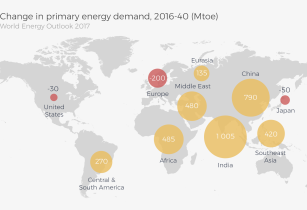The resurgence in oil and gas production in the US, decline in the cost of renewables and growing electrification are changing the traditional ways of meeting energy demand globally, according to the World Energy Outlook (WEO) 2017
The world's growing energy needs are met first by renewable and natural gas, as fast-declining costs turn solar power into the cheapest source of new electricity generation.
According to the International Energy Agency (IEA), the global energy demand will be 30 per cent higher by 2040. The report has said that in the next two decades, the global energy system will be reshaped by four major forces.
?The United States is set to become the undisputed global oil and gas leader; renewable are being deployed rapidly thanks to falling costs; the share of electricity in the energy mix is growing; and China's new economic strategy takes it on a cleaner growth mode, with implications for global energy markets,? said the report.
Solar PV is expected to lead capacity additions, as pushed by deployment in China and India, with the wind becoming the leading source of electricity after 2030 in the European Union.
"Solar is forging ahead in global power markets as it becomes the cheapest source of electricity generation in many places, including China and India,? said Dr Fatih Birol, executive director in the IEA.
?Electric vehicles (EVs) are in the fast lane as a result of government support and declining battery costs but it is far too early to write the obituary of oil, as growth for trucks, aviation, petrochemicals, shipping and aviation keep pushing demand higher. The US becomes the undisputed leader for oil and gas production for decades, which represents a major upheaval for international market dynamics,? Birol added.
The report has included a special focus on China in 2017, noting that economic and energy policy changes pose an impact on the country's energy mix.
China?s emphasis on cleaner energy technologies is catapulting the country to a position as a world leader in wind, solar, nuclear and electric vehicles. As demand growth in China slows, other countries continue to push overall global demand higher, with India accounting for almost one-third of global growth to 2040, according to the report.
By the mid-2020s, the US is projected to become the world's largest LNG exporter and a net oil exporter by the end of that decade, said IEA.
This creates a major impact on oil and gas markets, challenging incumbent suppliers and provoking a major reorientation of global trade flows, with consumers in Asia accounting for more than 70 per cent of global oil and gas imports by 2040.






